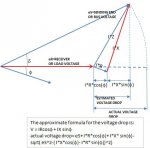up&coming1
Member
- Location
- Nashville, T.N
does anyone have any idea of another way to calculate voltage drop besides : 2 x 12.9 (copper) x distance x amperge/ cmils ?
21.2 ( aluminum)
21.2 ( aluminum)
does anyone have any idea of another way to calculate voltage drop besides : 2 x 12.9 (copper) x distance x amperge/ cmils ?
21.2 ( aluminum)
Make sure to replace "2" with sqrt(3) or 1.732, when dealing with 3-phase.

2 (or 1.732) x Resistance (ohms/kft) x current (I) x Distance (feet)does anyone have any idea of another way to calculate voltage drop besides : 2 x 12.9 (copper) x distance x amperge/ cmils ?
21.2 ( aluminum)
2 (or 1.732) x Resistance (ohms/kft) x current (I) x Distance (feet)
R.I.D. method for short. Use NEC Chapter 9, Table 9 (or 8, if applicable) for Ohms to Neutral per 1000 feet for R values.
Table 8 is DC resistance values. Use Table 9 for AC... adjust value for power factor.Ed=KIL/CSA
Eg
Table 8
K= 10.4 for #14
#14 =4110 cir mils
Plug in the senario you want
The total length is out and back hot to neutral
Single phase or or three it phase doesn't mater
It's the length , wire size, temp and impedance
will all effect the ED
...where CSA units are circular mils.R = K/CSA
E=IR
As I mentioned earlier, all voltage drop calculations are just a variation on Ohm's Law.If it's single phase and for some reason you don't want to use the normal voltage drop calc. method then you can use Ohm's law. Any particular reason you don't want to use the 2KID/CMIL method?
As I mentioned earlier, all voltage drop calculations are just a variation on Ohm's Law.
Table 8 is DC resistance values. Use Table 9 for AC... adjust value for power factor.
Where'd you get the K= 10.4 for #14?
Resistance of metal alloys,
Ohms resistance per mil foot
Copper,annealed =10.4
K= resistivity of materials
R=kxL/A
A= cross-sectional area in CM
FWIW......where CSA units are circular mils.
All voltage drop formulas amount to:
E=I x R is used for DC circuit or for true power calcs not forWell, it's all V=I*R in some form or another. It's just a matter of how one determines the value of R, that makes the difference in the methods.
Common misconception. V=I*R is not Ohm's law, but rather a way to write the definition of resistance. R=V/I is the formula that shows this definition directly. For our purposes though, it still works as a shortcut to call this Ohm's law.
Georg Ohm's actual law, is that resistance is independent of voltage and current, which therefore makes the relationship between V and I linear. Meaning, an ordinary material doesn't behave like a diode or a varistor, that can classify as insulators at one voltage and conductors at another voltage. Diodes and Varistors have a variation of resistance as a function of the voltage, and thus are components that operate outside of Ohm's law.
The question was...What's the question?
And your reply is...???Where'd you get the K= 10.4 for #14?
Do you realize that in most scientific circles (i.e. non-electrical) that resistivity is given for materials at 20°C?Resistance of metal alloys,
Ohms resistance per mil foot
Copper,annealed =10.4
K= resistivity of materials
R=kxL/A
A= cross-sectional area in CM
